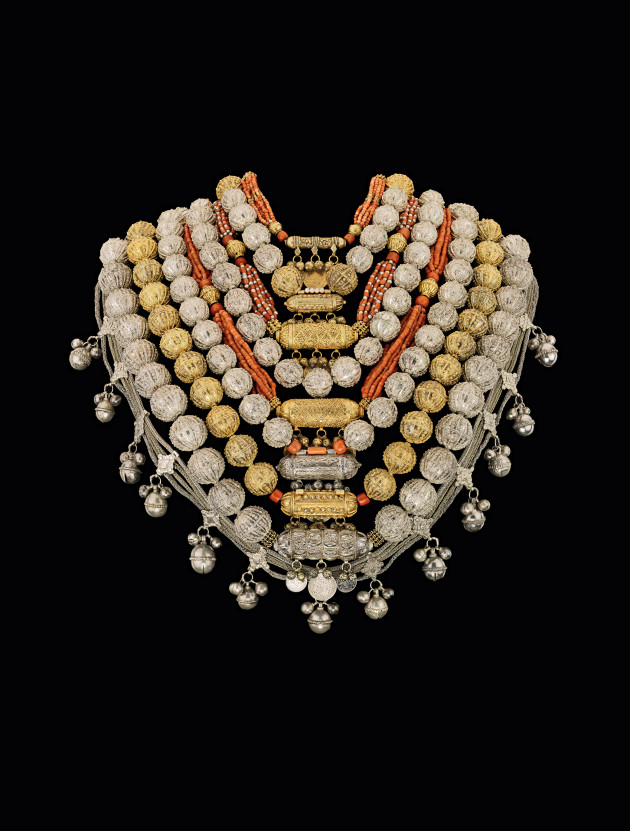Tag : jewelry
July 15, 2014 by admin
The Art of Ornament

Bridal jewellery, Sana’a, Yemen, 1930s–1940s, silver and gilt-silver filigree and granulation, corals, coins, The Israel Museum, Jerusalem.
Israel boasts an exciting and very hip cadre of extraordinary visual artists, yet their work in jewelry design and fashion can elude the radar. Time to take notice! For many decades, this work —much of it by women —has been created in a fascinating space between cutting-edge and traditional, pushing the boundaries of how we think to adorn ourselves. Here, an introduction to some very dramatic “worn ornaments” made by women artists —in different eras and emerging from diverse cultures —since the founding of the State of Israel.
Jewelry in Israel (Arnoldsche Art Publishers, 2013) is a bravura book featuring more than 60 unique contemporary Israeli artist/jewelers by art historian Iris Fischof. This exceptional volume brings to international attention the astonishing diversity of talent, expertise and creativity of Israeli artists working in the format of jewelry objects. Fishof rightly contends that each artist’s voice is an individual statement clarifying the ‘idea’ of jewelry worn as adornment, as personal/political identification, empowerment, as status and prestige. The artists have been selected for their singular concepts and command of technique. Each is highly skilled, envisioning a sculptural form both wearable and thought provoking. Precious metals and gemstones have a low importance but texture, color, surface and pattern are used with ingenuity. Fishof clearly identifies the maker’s national background, academic affiliation, age and life events, careful not to label this diversity as the collective definition of ‘Israeli’.

Deganit Stern Schocken, Mouth, pendant from the series “Figure of Speech”, 2011, stainless steel, polystyrene, gold, silver, zircon, nylon, cotton thread.
The subtitle of this book is one of its strengths, Multicultural Diversity 1948 to the Present, with chapters dealing on the ‘melting pot’ period of immigration, 1950–1970, international outreach, and support of fellow artists 1950–1970 and in the 1970’s, of world acclaim. Four of these jeweler/artists that found global recognition, are Bianca Eshel Gershuni, Vered Kaminski, Esther Knobel and Daganit Stern Schocken. The shared history of Holocaust, immigration, internal political strife, constant tensions both physical and psychological have led to a vocabulary of materials and images like none other.
Gorgeous as much of this work is, it is the impact of such pieces such as ‘fish-airplane’ brooches by Gershuni, crafted during the Gulf War (1991), the repeated, referential use of metal webbing, a reminder of the windscreen protective mesh during the period of the Intifada attacks in 1987–2000, by Vered Kaminski and the motif of memorial wreaths for fallen protectors by amongst others, Michal Bar-On Shaish. These artists turned tragic events and industrial/found object materials into beautiful personal jewelry challenging the intent to annihilate and destroy. The most potent of Jewish symbols, the Magen David star is used sparingly, except in an inverted reference to the mandatory Nazi identity badge, the ‘yellow star/Jude’. Instead several artists including Zoya Cherkassy and Degnit Stern Schocken create positive I.D. brooches in delicately wrought 18k gold, turning a dangerous negative into praise worthy pride.

Vered Kaminski, brooch, 2010, silver, turquoise, presented by Israel’s President Shimon Peres to German Chancellor Angela Merkel, 2010.
Historically, jewelers evolved from family based workshops/ businesses. Jews were barred entry in any of the European ‘guilds‘ and trade associations commencing in the 14th century. Unable to learn professional skills, the outsider tradition of the self-taught passed generationally, inspired by native, local craft traditions and importantly included women as workers. Many highly competent women were the unseen, unsung anonymous fabricators of jewelry. Since the 1948 founding of the State of Israel, women have been accepted as equals on the battlefield, on the collective farms and in the jewelry studios.
Israeli support for the arts continues to grow, with the leading educational sources for professional jewelry/handmade objects being the Bezalel Academy in Jerusalem and the Shenkar College of Engineering and Design in Ramat Gan. In 2006, Edgar Bronfman created an annual prize, the Andy, in memory of his wife Andrea, herself a great collector and supporter of contemporary Israeli crafts. Recognition of this award is furthered by an annual solo exhibition in the Eretz-Israel Museum, Tel Aviv.
In singling out any of the more than 60 distinctive artists applauded in this volume I do so based on my many professional years in the contemporary jewelry world as a dealer, curator and collector.
These artists are featured in fine art galleries and contemporary museum jewelry collections throughout the world. The photography and art direction of this volume is of the highest order, appropriate for this sophisticated art book.
- No Comments
 Please wait...
Please wait...